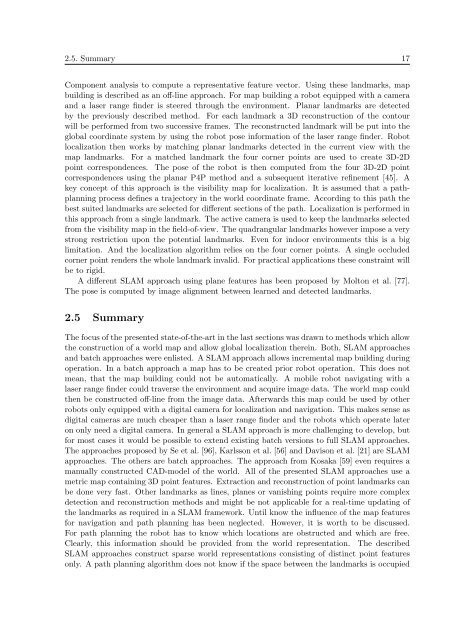PHD Thesis - Institute for Computer Graphics and Vision - Graz ...
PHD Thesis - Institute for Computer Graphics and Vision - Graz ...
PHD Thesis - Institute for Computer Graphics and Vision - Graz ...
You also want an ePaper? Increase the reach of your titles
YUMPU automatically turns print PDFs into web optimized ePapers that Google loves.
2.5. Summary 17<br />
Component analysis to compute a representative feature vector. Using these l<strong>and</strong>marks, map<br />
building is described as an off-line approach. For map building a robot equipped with a camera<br />
<strong>and</strong> a laser range finder is steered through the environment. Planar l<strong>and</strong>marks are detected<br />
by the previously described method. For each l<strong>and</strong>mark a 3D reconstruction of the contour<br />
will be per<strong>for</strong>med from two successive frames. The reconstructed l<strong>and</strong>mark will be put into the<br />
global coordinate system by using the robot pose in<strong>for</strong>mation of the laser range finder. Robot<br />
localization then works by matching planar l<strong>and</strong>marks detected in the current view with the<br />
map l<strong>and</strong>marks. For a matched l<strong>and</strong>mark the four corner points are used to create 3D-2D<br />
point correspondences. The pose of the robot is then computed from the four 3D-2D point<br />
correspondences using the planar P4P method <strong>and</strong> a subsequent iterative refinement [45]. A<br />
key concept of this approach is the visibility map <strong>for</strong> localization. It is assumed that a pathplanning<br />
process defines a trajectory in the world coordinate frame. According to this path the<br />
best suited l<strong>and</strong>marks are selected <strong>for</strong> different sections of the path. Localization is per<strong>for</strong>med in<br />
this approach from a single l<strong>and</strong>mark. The active camera is used to keep the l<strong>and</strong>marks selected<br />
from the visibility map in the field-of-view. The quadrangular l<strong>and</strong>marks however impose a very<br />
strong restriction upon the potential l<strong>and</strong>marks. Even <strong>for</strong> indoor environments this is a big<br />
limitation. And the localization algorithm relies on the four corner points. A single occluded<br />
corner point renders the whole l<strong>and</strong>mark invalid. For practical applications these constraint will<br />
be to rigid.<br />
A different SLAM approach using plane features has been proposed by Molton et al. [77].<br />
The pose is computed by image alignment between learned <strong>and</strong> detected l<strong>and</strong>marks.<br />
2.5 Summary<br />
The focus of the presented state-of-the-art in the last sections was drawn to methods which allow<br />
the construction of a world map <strong>and</strong> allow global localization therein. Both, SLAM approaches<br />
<strong>and</strong> batch approaches were enlisted. A SLAM approach allows incremental map building during<br />
operation. In a batch approach a map has to be created prior robot operation. This does not<br />
mean, that the map building could not be automatically. A mobile robot navigating with a<br />
laser range finder could traverse the environment <strong>and</strong> acquire image data. The world map could<br />
then be constructed off-line from the image data. Afterwards this map could be used by other<br />
robots only equipped with a digital camera <strong>for</strong> localization <strong>and</strong> navigation. This makes sense as<br />
digital cameras are much cheaper than a laser range finder <strong>and</strong> the robots which operate later<br />
on only need a digital camera. In general a SLAM approach is more challenging to develop, but<br />
<strong>for</strong> most cases it would be possible to extend existing batch versions to full SLAM approaches.<br />
The approaches proposed by Se et al. [96], Karlsson et al. [56] <strong>and</strong> Davison et al. [21] are SLAM<br />
approaches. The others are batch approaches. The approach from Kosaka [59] even requires a<br />
manually constructed CAD-model of the world. All of the presented SLAM approaches use a<br />
metric map containing 3D point features. Extraction <strong>and</strong> reconstruction of point l<strong>and</strong>marks can<br />
be done very fast. Other l<strong>and</strong>marks as lines, planes or vanishing points require more complex<br />
detection <strong>and</strong> reconstruction methods <strong>and</strong> might be not applicable <strong>for</strong> a real-time updating of<br />
the l<strong>and</strong>marks as required in a SLAM framework. Until know the influence of the map features<br />
<strong>for</strong> navigation <strong>and</strong> path planning has been neglected. However, it is worth to be discussed.<br />
For path planning the robot has to know which locations are obstructed <strong>and</strong> which are free.<br />
Clearly, this in<strong>for</strong>mation should be provided from the world representation. The described<br />
SLAM approaches construct sparse world representations consisting of distinct point features<br />
only. A path planning algorithm does not know if the space between the l<strong>and</strong>marks is occupied















